The Relationship between Urbanization and the Water Environment in the Chengdu-Chongqing Urban Agglomeration
Abstract
1. Introduction
2. Materials and Methods
2.1. Study Area
2.2. Research Framework
- ■
- Creates a connotation mode. This allows for a more complete and accurate assessment of urbanization and water environment levels.
- ■
- Preprocess the data from the study area for the period 2011–2018 and determine the weight of each index layer using the entropy value method. This helps to accurately show how important each factor is in the overall analysis.
- ■
- Establish a comprehensive index system for urbanization and the water environment. Ensure that all relevant factors are considered to provide a holistic assessment.
- ■
- Develop a CCD model and a spatial autocorrelation model. This is essential to quantifying the relationship between urbanization and the water environment and to understanding the spatial patterns of these interactions.
- ■
- Calculate the value of CCD and global and local spatial autocorrelation. This helps to understand the trends and spatial characteristics of their interaction, providing a clear picture of their coupled dynamics.
2.3. Methods
2.3.1. Data Source
2.3.2. Indicator System and Weights
2.3.3. Coupling Coordination Model
- (1)
- Calculation of comprehensive index
- (2)
- Calculation of coupling degree and coupling coordination degree
2.3.4. Spatial Autocorrelation Model
3. Results
3.1. Progress of Urbanization and Water Environment Progress
3.1.1. Urbanization Level Evaluation
3.1.2. Water Environment Quality Evaluation
3.1.3. Analysis of the Interaction between Urbanization and Water Environment
3.2. Coupling Coordination Analysis of Urbanization and Water Environment
3.2.1. Time-Series Variation Characteristics of the Coupling Coordination Degree
- (1)
- 2011–2015: the coordination status between the two systems was initially at a medium level. In 2011, except for the two central cities, all other cities were in a basic coordination status. During the period of 2012–2015, Chengdu developed well, and the adjustment of the industrial structure brought a continuous increase in the resident population and an increase in the proportion of employment in the tertiary industry, driving population urbanization. At the same time, the economic benefits were also reflected in the rapid growth of per capita fixed asset investment and per capita disposable income of urban residents, which was reflected in the rapid increase of the economic urbanization index. These two subsystems drove the urbanization level to improve, slightly less than the water environment level, and Chengdu City entered a good coordination state. The simultaneous improvement of the four subsystems of population, space, economy, and society in Chongqing made the urbanization level converge to the level of the water environment and enter a coordinated state. Driven by Chengdu and Chongqing, the economic and demographic urbanization subsystems of other cities rapidly improved, thus driving the rapid growth of urbanization performance; the performance of the water environment system slightly improved, the gap between the two systems decreased and the connection began to strengthen, and the coordination state began to improve. Taken together, the steady increase in urbanization during this period effectively drove the growth of coordination and the linkages between the two systems began to strengthen.
- (2)
- 2016–2019: The state between urbanization and the water environment system in CCUA gradually transitioned to the coordination stage. Basic coordination, coordination, and good coordination accounted for 62.50%, 31.26%, and 6.25% in 2016, respectively. Basic coordination, coordination, and good coordination accounted for 6.25%, 81.25%, and 12.50% in 2019, respectively. Only one city, Dazhou, did not reach the coordination status. From this comparison, it is obvious that the percentage of cities in a coordinated state has increased significantly. During this period, with the deepening cooperation of regional integration, the water environment performance was relatively stable, while the urbanization of each city grew one after another under the continuous promotion of economic and population subsystems, which effectively pushed the two systems to begin to change to a coordinated state. However, the mismatch between the two systems in these cities has not changed significantly, and the development of urbanization still lags behind the water environment, so it is clear that these cities still need to continuously improve the level of urbanization.
3.2.2. Change Characteristics of Coupling Coordination in Spatial Dimension
4. Conclusions and Discussion
Author Contributions
Funding
Data Availability Statement
Conflicts of Interest
References
- Wang, M.; Liu, X.; Liu, Z.; Wang, F.; Li, X.; Hou, G.; Zhao, S. Evaluation and Driving Force Analysis of Cultivated Land Quality in Black Soil Region of Northeast China. Chin. Geogr. Sci. 2023, 33, 601–615. [Google Scholar] [CrossRef]
- Ma, H.; Shi, C.; Chou, N.-T. China’s Water Utilization Efficiency: An Analysis with Environmental Considerations. Sustainability 2016, 8, 516. [Google Scholar] [CrossRef]
- Dong, G.; Shen, J.; Jia, Y.; Sun, F. Comprehensive Evaluation of Water Resource Security: Case Study from Luoyang City, China. Water 2018, 10, 1106. [Google Scholar] [CrossRef]
- Bogardi, J.J.; Dudgeon, D.; Lawford, R.; Flinkerbusch, E.; Meyn, A.; Pahl-Wostl, C.; Vielhauer, K.; Vörösmarty, C. Water security for a planet under Water security for a planet under pressure: Interconnected challenges of a changing world call for sustainable solutions. Curr. Opin. Environ. Sustain. 2012, 4, 35–43. [Google Scholar] [CrossRef]
- Reid, W.V.; Chen, D.; Goldfarb, L.; Hackmann, H.; Lee, Y.T.; Mokhele, K.; Ostrom, E.; Raivio, K.; Rockström, J.; Schellnhuber, H.J.; et al. Earth System Science for Global Sustainability: Grand Challenges. Global Sustainability: Grand Challenges. Science 2010, 330, 916–917. [Google Scholar] [CrossRef] [PubMed]
- Haase, D.; Güneralp, B.; Dahiya, B.; Bai, X.; Elmqvist, T. Global urbanization. J. Urban Planet Knowl. Sustain. Cities 2018, 19, 326–339. [Google Scholar]
- Pan, T.; Kuang, W.; Shao, H.; Zhang, C.; Wang, X.; Wang, X. Urban expansion and intra-urban land evolution as well as their natural environmental constraints in arid/semiarid regions of China from 2000–2018. J. Geogr. Sci. 2023, 33, 1419–1441. [Google Scholar] [CrossRef]
- Fang, C.; Yu, D. Urban agglomeration: An evolving concept of an emerging phenomenon. Landsc. Urban Plan. 2017, 162, 126–136. [Google Scholar] [CrossRef]
- Jiang, Y. China’s water scarcity. J. Environ. Manag. 2009, 90, 3185–3196. [Google Scholar] [CrossRef] [PubMed]
- Liu, M.; Wei, J.; Wang, G.; Wang, F. Water resources stress assessment and risk early warning-a case of Hebei Province China. Ecol. Indic. 2017, 73, 358–368. [Google Scholar] [CrossRef]
- Bao, C.; Fang, C.-L. Water Resources Flows Related to Urbanization in China: Challenges and Perspectives for Water Management and Urban. Water Resour. Manag. 2011, 26, 531–552. [Google Scholar] [CrossRef]
- Feng, L.; Chen, B.; Hayat, T.; Alsaedi, A.; Ahmad, B. The driving force of water footprint under the rapid urbanization process: A structural decomposition analysis for Zhangye city in China. J. Clean. Prod. 2017, 163, S322–S328. [Google Scholar] [CrossRef]
- Zhang, L.Y.; Zhang, Z.; Chen, Y.; Tao, F.L. Spatial pattern of surface water quality in China and its driving factors-implication for the environmental sustainability. Hum. Ecol. Risk Assess. 2019, 25, 1789–1801. [Google Scholar] [CrossRef]
- Falkenmark, M.; Lundqvist, J.; Widstrand, C. Macro-scale water scarcity requires micro-scale approaches. Nat. Resour. Forum 1989, 13, 258–267. [Google Scholar] [CrossRef] [PubMed]
- Gossweiler, B.; Wesstrom, I.; Messing, I.; Romero, A.M.; Joel, A. Spatial and Temporal Variations in Water Quality and Land Use in a Semi-Arid Catchment in Bolivia. Water 2019, 11, 2227. [Google Scholar] [CrossRef]
- Graniel, C.; Morris, L.; Carrillo-Rivera, J. Effects of urbanization on groundwater resources of Merida, Yucatan, Mexico. Environ. Geol. 1999, 37, 303–312. [Google Scholar] [CrossRef]
- Zhou, F.; Xu, Y.P.; Chen, Y.; Xu, C.Y.; Gao, Y.Q.; Du, J.K. Hydrological response to urbanization at different spatio-temporal scales simulated by coupling of CLUE-S and the SWAT model in the Yangtze River Delta region. J. Hydrol. 2013, 485, 113–125. [Google Scholar] [CrossRef]
- Kim, Y.; Newman, G.; Güneralp, B. A review of driving factors, scenarios, and topics in urban land change models. Land 2020, 9, 246. [Google Scholar] [CrossRef]
- Meierdiercks, K.L.; Smith, J.A.; Baeck, M.L.; Miller, A.J. Heterogeneity of Hydrologic Response in Urban Watersheds. JAWRA J. Am. Water Resour. Assoc. 2010, 46, 1221–1237. [Google Scholar] [CrossRef]
- Sun, X.; Zhang, H.; Hua, D.; Wei, B. The Influence of Urbanization on Storm Runoff. Front. Environ. Prot. 2021, 11, 654–659. [Google Scholar] [CrossRef]
- Bao, C.; He, D.M. Scenario Modeling of Urbanization Development and Water Scarcity Based on System Dynamics: A Case Study of Beijing-Tianjin-Hebei Urban Agglomeration, China. Int. J. Environ. Res. Public Health 2019, 16, 3834. [Google Scholar] [CrossRef] [PubMed]
- Meinzen-Dick, R.; Appasamy, P. Urbanization and Intersectoral Competition for Water. In Finding the Source: The Linkages between Population and Water; ESCP: Paris, France, 2002; pp. 27–51. [Google Scholar]
- Orubu, C.O.; Omotor, D.G. Environmental quality and economic growth: Searching for environmental Kuznets curves for air and water pollutants in Africa. Energy Policy 2011, 39, 4178–4188. [Google Scholar] [CrossRef]
- Carroll, B.A. Strategic water planning for south east England: Preparing for proposed development. Water Sci. Technol. J. Int. Assoc. Water Pollut. Res. 2003, 48, 9–16. [Google Scholar] [CrossRef]
- Bao, C.; Fang, C.-L. Analysis of spatial and temporal variation of water resources on the intensity of urbanization constraints in arid regions. J. Geogr. 2008, 63, 1140–1150. [Google Scholar]
- Zhang, Z.; Shi, M.; Chen, K.Z.; Yang, H.; Wang, S. Water scarcity will constrain the formation of a world-class megalopolis in North China. NPJ Urban Sustain. 2021, 1, 13. [Google Scholar] [CrossRef]
- Ma, H.L.; Chou, N.T.; Wang, L. Dynamic Coupling Analysis of Urbanization and Water Resource Utilization Systems in China. Sustainability 2016, 8, 1176. [Google Scholar] [CrossRef]
- Wu, X.Y.; Xu, C.X.; Pang, Q.H. Analysis on Driving Effect of the Urbanization Development Speed on Water Resources Conflict. Math. Probl. Eng. 2017, 2017, 6810120. [Google Scholar] [CrossRef]
- Cui, D.; Chen, X.; Xue, Y.L.; Li, R.; Zeng, W.H. An integrated approach to investigate the relationship of coupling coordination between social economy and water environment on urban scale—A case study of Kunming. J. Environ. Manag. 2019, 234, 189–199. [Google Scholar] [CrossRef] [PubMed]
- Kalantari, Z.; Ferreira, C.S.S.; Page, J.; Goldenberg, R.; Olsson, J.; Destouni, G. Meeting sustainable development challenges in growing cities: Coupled social-ecological systems modeling of land use and water changes. J. Environ. Manag. 2019, 245, 471–480. [Google Scholar] [CrossRef]
- Bhaskar, A.S.; Jantz, C.; Welty, C.; Drzyzga, S.A.; Miller, A.J. Coupling of the Water Cycle with Patterns of Urban Growth in the Baltimore Metropolitan Region, United States. JAWRA J. Am. Water Resour. Assoc. 2016, 52, 1509–1523. [Google Scholar] [CrossRef]
- Zhang, H.; Lai, H.L. Analysis of the interactive coupling mechanism between the development of Kunming main city and Dianchi water environment from 1998 to 2008. China Soil Water Conserv. 2012, 000, 64–66. [Google Scholar]
- Anwar, A.; Sinha, A.; Sharif, A.; Siddique, M.; Irshad, S.; Anwar, W.; Malik, S. The nexus between urbanization, renewable energy consumption, financial development, and CO2 emissions: Evidence from selected Asian countries. Environ. Dev. Sustain. 2022, 24, 6556–6576. [Google Scholar] [CrossRef]
- Expósito, A.; Pablo-Romero, M.; Sánchez-Braza, A. Testing EKC for Urban Water Use: Empirical Evidence at River Basin Scale from the Guadalquivir River, Spain. J. Water Resour. Plan. Manag. 2019, 145, 04019005. [Google Scholar] [CrossRef]
- Chen, A.; Gao, J. Urbanization in China and the Coordinated Development Model-The case of Chengdu. Soc. Sci. J. 2011, 48, 500–513. [Google Scholar] [CrossRef]
- Chen, X. China Urban Statistical Yearbook: 2019; China Statistics Press: Beijing, China, 2020. [Google Scholar]
- Xiong, J.; Zeng, J. Sichuan Statistical Yearbook 2020 (38th Issue in Total); China Statistical Publishing House Co., Ltd.: Beijing, China, 2020. [Google Scholar]
- Yang, H.; Li, T. Chongqing Statistical Yearbook 2020; China Statistical Publishing House: Beijing, China, 2020. [Google Scholar]
- Liao, S.; Wu, Y.; Wong, S.W.; Shen, L. Provincial perspective analysis on the coordination between urbanization growth and resource environment carrying capacity (RECC) in China. Sci. Total Environ. 2020, 730, 138964. [Google Scholar] [CrossRef] [PubMed]
- Ding, L.; Zhao, W.T.; Huang, Y.L.; Cheng, S.G.; Liu, C. Research on the Coupling Coordination Relationship between Urbanization and the Air Environment: A Case Study of the Area of Wuhan. Atmosphere 2015, 6, 1539–1558. [Google Scholar] [CrossRef]
- Wang, Z.B.; Liang, L.W.; Sun, Z.; Wang, X.M. Spatiotemporal differentiation and the factors influencing urbanization and ecological environment synergistic effects within the Beijing-Tianjin-Hebei urban agglomeration. J. Environ. Manag. 2019, 243, 227–239. [Google Scholar] [CrossRef]
- Lin, X.; Lu, C.; Song, K.; Su, Y.; Lei, Y.; Zhong, L.; Gao, Y. Analysis of Coupling Coordination Variance between Urbanization Quality and Eco-Environment Pressure: A Case Study of the West Taiwan Strait Urban Agglomeration, China. Sustainability 2020, 12, 2643. [Google Scholar] [CrossRef]
- Whitall, D.; Bricker, S.; Ferreira, J.; Nobre, A.M.; Simas, T.; Silva, M. Assessment of Eutrophication in Estuaries: Pressure-State -Response and Nitrogen Source Apportionment. Environ. Manag. 2007, 40, 678–690. [Google Scholar] [CrossRef]
- Liu, D.; Hao, S. Ecosystem Health Assessment at County-Scale Using the Pressure- State-Response Framework on the Loess Plateau, China. Int. J. Environ. Res. Public Health 2017, 14, 2. [Google Scholar] [CrossRef]
- Neri, A.C.; Dupin, P.; Sánchez, L.E. A pressure-state-response approach to cumulative impact assessment. J. Technol. Sci. 2016, 126, 288–298. [Google Scholar] [CrossRef]
- Zhu, X.A.; Wei, G.D. Exploration of the criteria of goodness of dimensionless method in entropy method. Stat. Decis. 2015, 31, 12–15. [Google Scholar]
- Li, T.; Liao, H.; Yang, W.; Zhuang, W.; Shi, W. Spatio-temporal variation and coupling coordination of “land, population and industry” urbanization quality in Chongqing. Econ. Geogr. 2015, 35, 65–71. [Google Scholar]
- Liu, Y.B.; Song, X.F. Study on the coupling degree of urbanization and ecological environment and its prediction model. J. China Univ. Min. Technol. 2005, 34, 6. [Google Scholar]
- Wu, D.J.; Cao, L.; Chen, L.H. Principles and Applications of Covariance; Huazhong University of Technology Press: Wuhan, China, 1990; pp. 9–17. [Google Scholar]
- Moran, P.A. The Interpretation of Statistical Maps. J. R. Stat. Soc. Ser. B Methodol. 1948, 10, 243–251. [Google Scholar] [CrossRef]
- Anselin, L. Local Indicators of Spatial Association-LISA. Geogr. Anal. 1995, 27, 93–115. [Google Scholar] [CrossRef]
- Mei, C.X.; Xu, S.J.; Ouyang, J.; Shi, C. Spatial and temporal evolution of urban spatial interactions in the Pearl River Delta urban agglomeration in the last 20 years. Geoscience 2012, 32, 694–701. [Google Scholar]
- Li, J.; Zhang, Y. Study on the coordination of new urbanization and eco-efficiency coupling in the Yangtze River Delta urban agglomeration and the driving factors. Ecol. Econ. 2022, 38, 109–114+141. [Google Scholar]
- Han, H.; Li, H.; Zhang, K. Spatial-Temporal Coupling Analysis of the Coordination between Urbanization and Water Ecosystem in the Yangtze River Economic Belt. Int. J. Environ. Res. Public Health 2019, 16, 3757. [Google Scholar] [CrossRef]
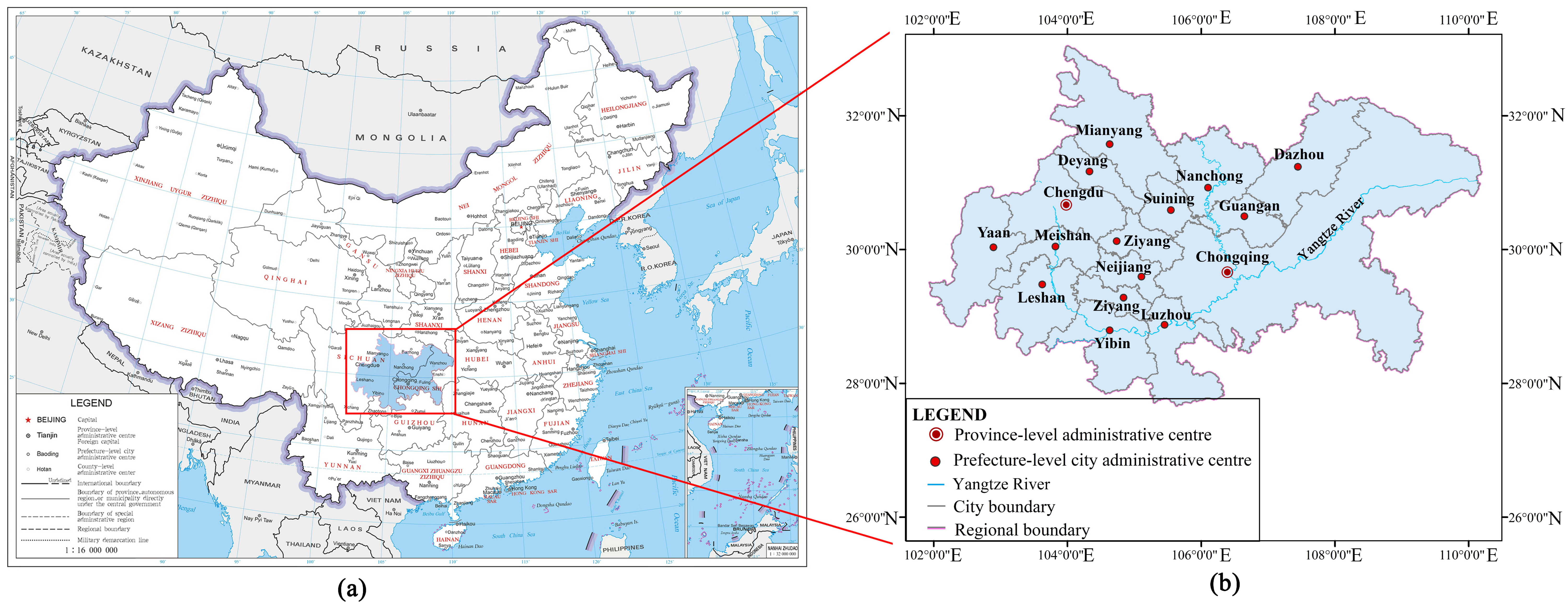
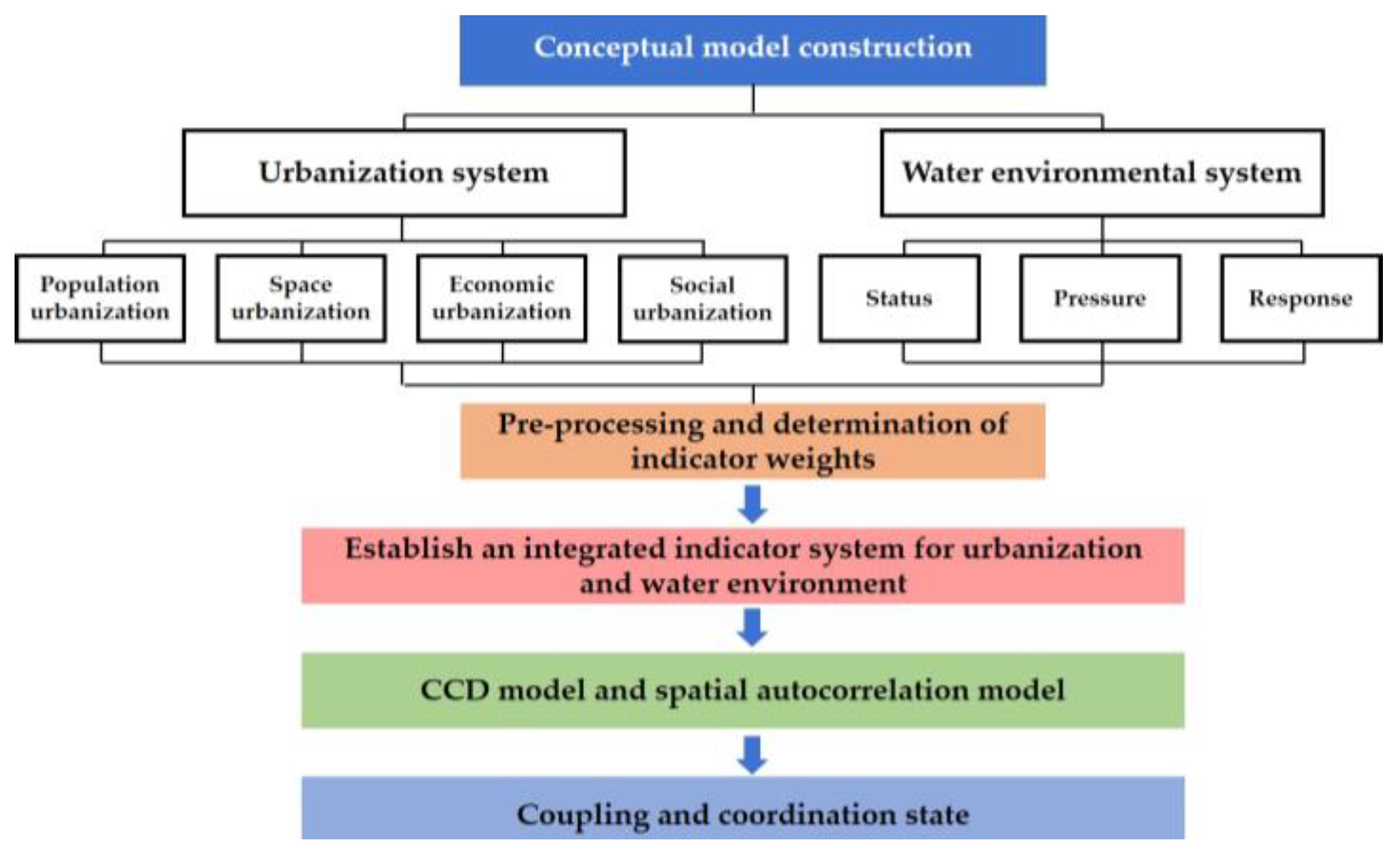

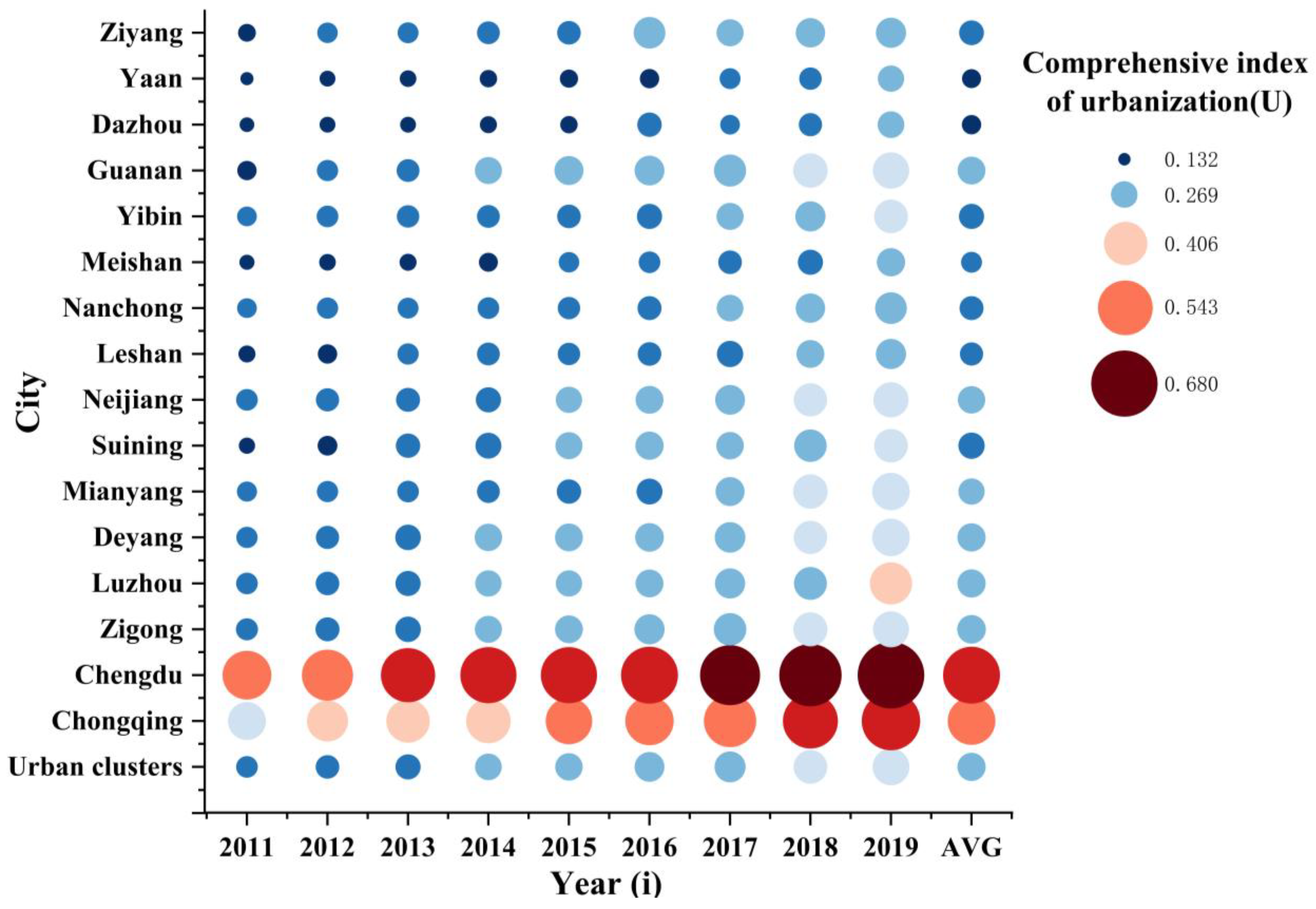
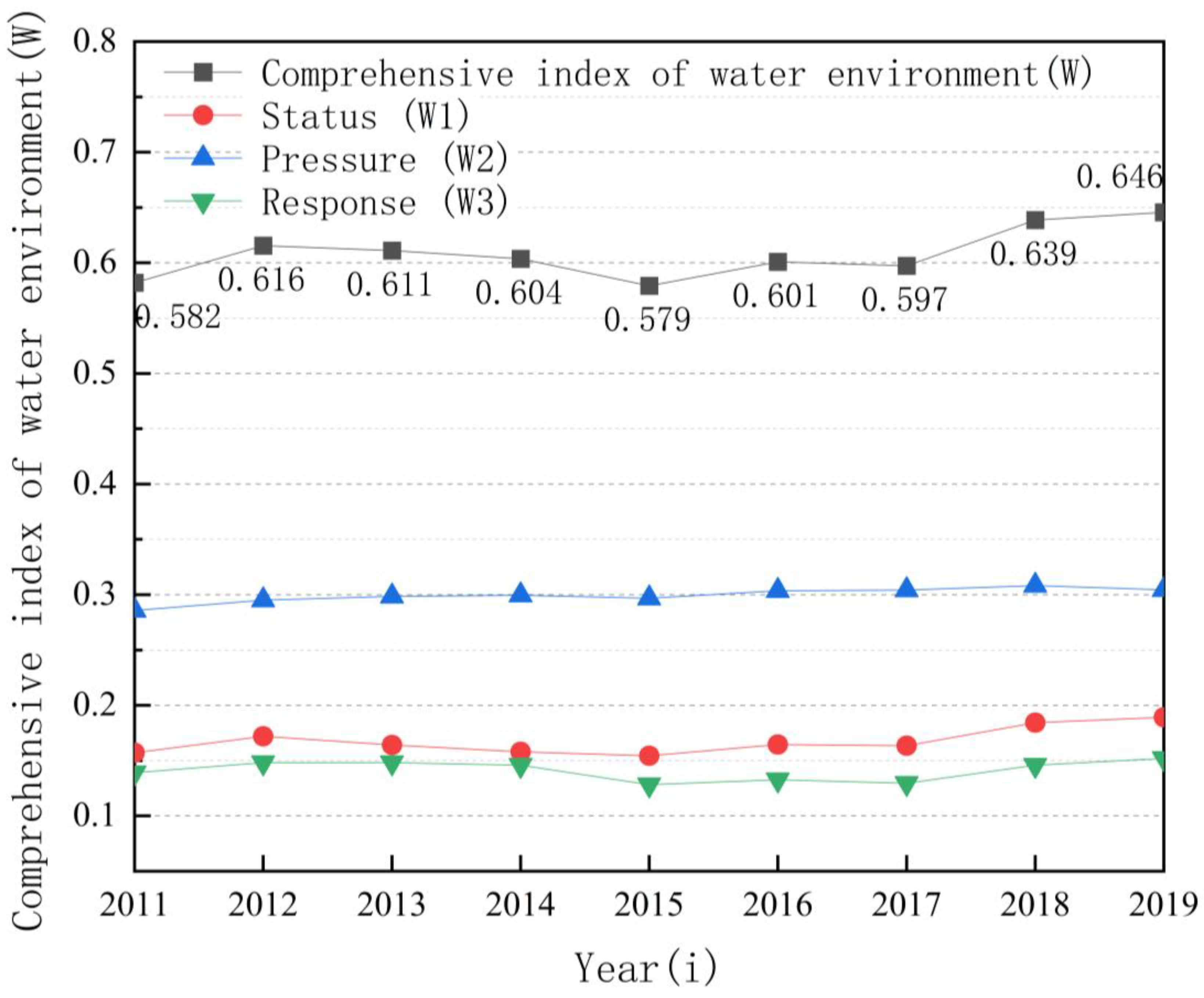
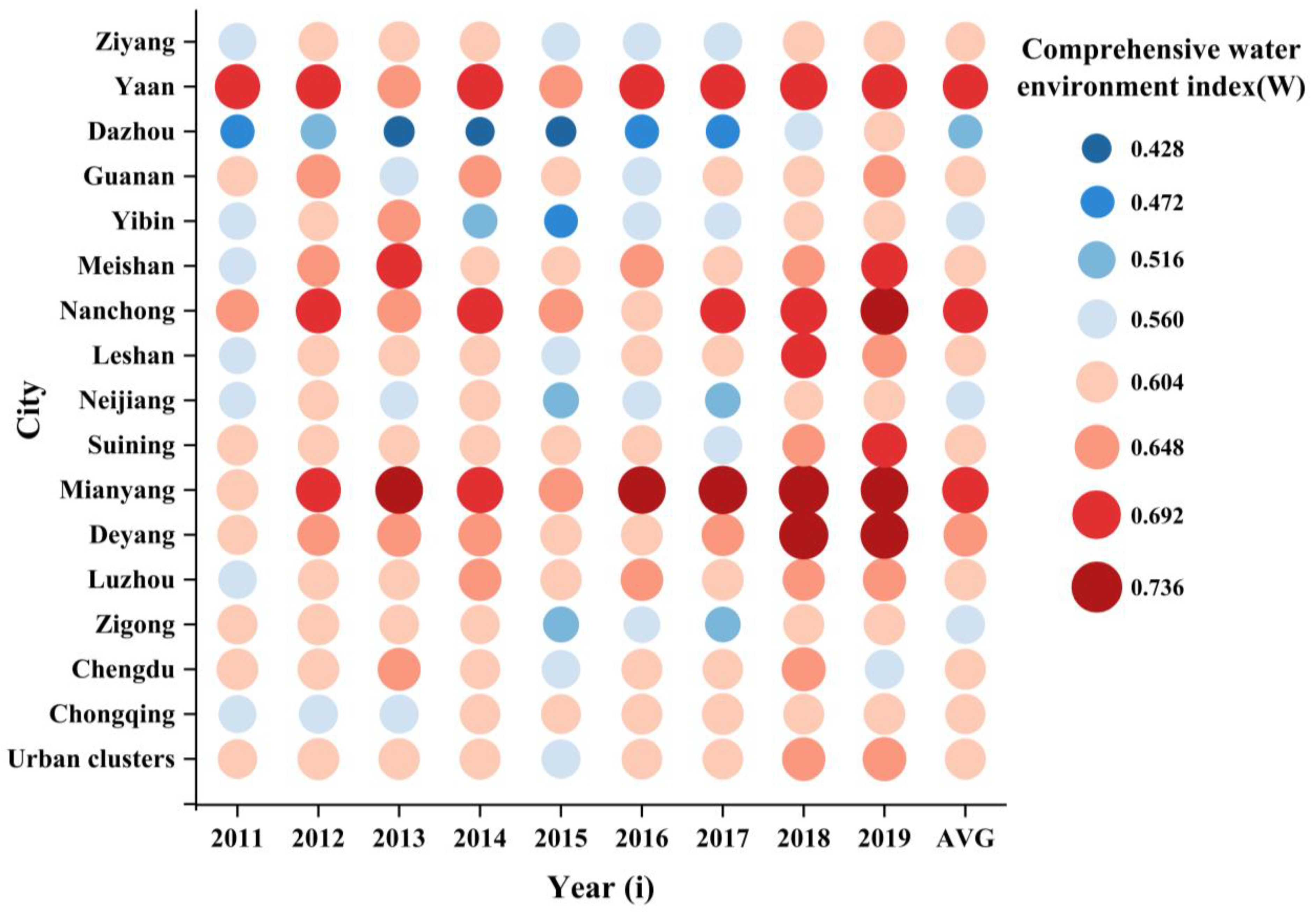

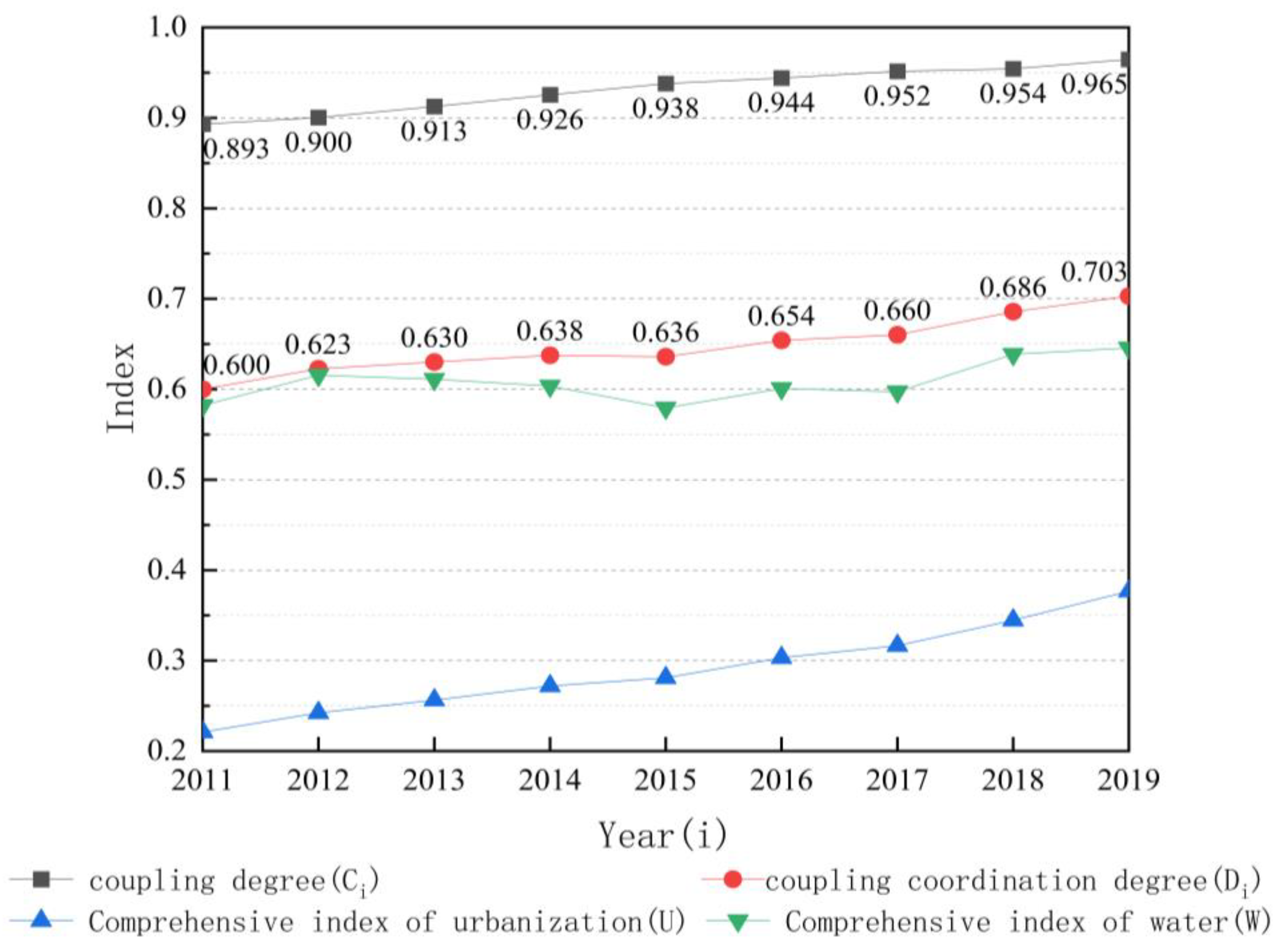

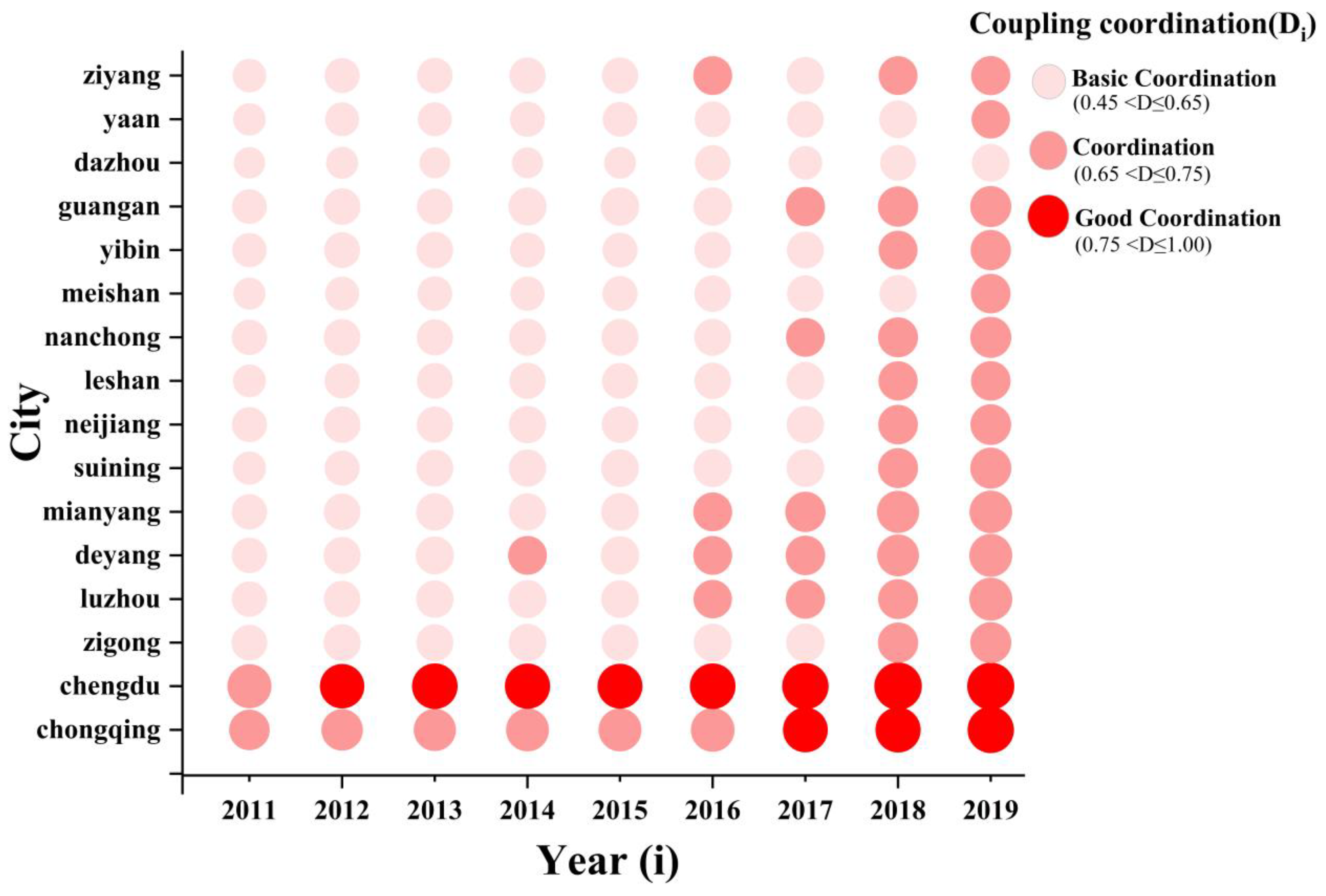

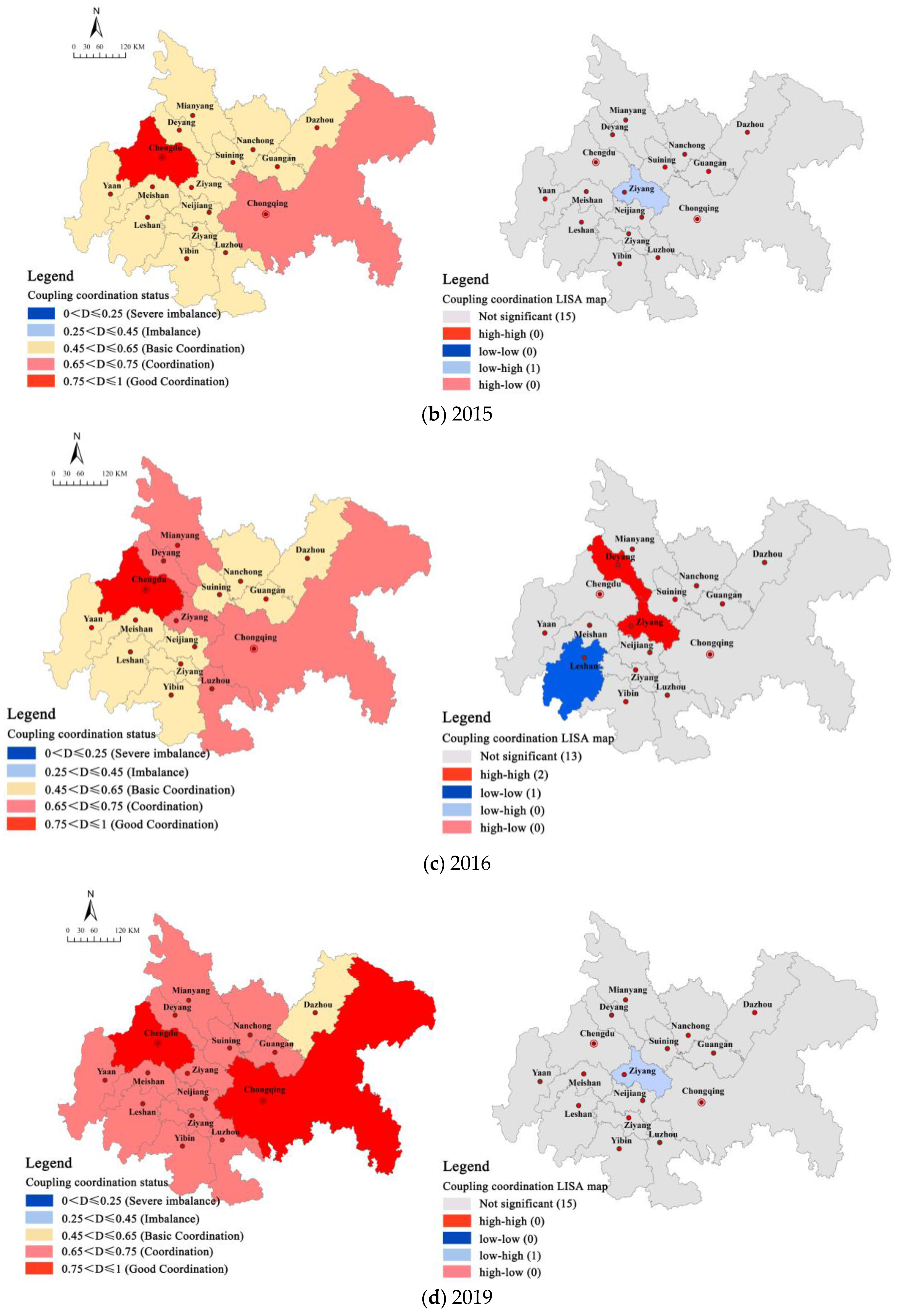
| System | Subsystems | Indicator Level |
|---|---|---|
| Urbanization (U) | Population urbanization (U1) | Urbanization rate of resident population (U11) |
| population density (U12) | ||
| Share of employment in the third sector (U13) | ||
| Urban registered unemployment rate (U14) | ||
| Space urbanization (U2) | built-up area as a proportion of the city area (U21) | |
| road network density (U22) | ||
| road area per capita (U23) | ||
| annual land acquisition area (U24) | ||
| Economic urbanization (U3) | GDP per capita (U31) | |
| I production weight (U32) | ||
| Fixed asset investment per capita (U33) | ||
| Disposable income per urban resident (U34) | ||
| Social urbanization (U4) | Number of doctors per 10,000 people (U41) | |
| Number of students in primary and secondary schools per 10,000 people (U42) | ||
| Year-end cell phone subscribers (U43) | ||
| Culture Center (Station) (U44) |
| System | Subsystems | Indicator Layer |
|---|---|---|
| Water Environment (W) | Status (W1) | Total Water Resources (W11) |
| water resources per capita (W12) | ||
| Water Resources Development and Utilization Rate (W13) | ||
| Water supply (use) penetration rate (W14) | ||
| Greening coverage of built-up areas (W15) | ||
| Pressure (W2) | million Yuan GDP water consumption (W21) | |
| Water consumption for secondary production (W22) | ||
| per capita daily domestic water consumption in urban areas (W23) | ||
| Urban sewage discharge (W24) | ||
| Industrial wastewater discharge (W25) | ||
| Response (W3) | Total water supply (W31) | |
| Density of drainage pipes in built-up areas (W32) | ||
| Water Conservation Reuse Rate (W33) | ||
| Centralized sewage treatment rate (W34) | ||
| Effective irrigation rate of cultivated land (W35) |
| Subsystems | Weights | Indicator Level | Weights |
|---|---|---|---|
| U1 | 0.2669 | U11 | 0.0682 |
| U12 | 0.0661 | ||
| U13 | 0.0651 | ||
| U14 | 0.0675 | ||
| U2 | 0.2391 | U21 | 0.0600 |
| U22 | 0.0689 | ||
| U23 | 0.0693 | ||
| U24 | 0.0409 | ||
| U3 | 0.2528 | U31 | 0.0628 |
| U32 | 0.0678 | ||
| U33 | 0.0544 | ||
| U34 | 0.0678 | ||
| U4 | 0.2412 | U41 | 0.0666 |
| U42 | 0.0664 | ||
| U43 | 0.0457 | ||
| U44 | 0.0625 |
| Subsystems | Weights | Indicator Layer | Weights |
|---|---|---|---|
| W1 | 0.3215 | W11 | 0.0527 |
| W12 | 0.0541 | ||
| W13 | 0.0713 | ||
| W14 | 0.0717 | ||
| W15 | 0.0717 | ||
| W2 | 0.3637 | W21 | 0.0725 |
| W22 | 0.0724 | ||
| W23 | 0.0727 | ||
| W24 | 0.0727 | ||
| W25 | 0.0734 | ||
| W3 | 0.3148 | W31 | 0.0503 |
| W32 | 0.0697 | ||
| W33 | 0.0563 | ||
| W34 | 0.0725 | ||
| W35 | 0.0660 |
| Coupling Phase | C-Value | Features |
|---|---|---|
| Irrelevant stage | C = 0 | The elements within the system are in an unrelated state and independent of each other |
| Low-level coupling stage | 0 < C ≤ 0.3 | Low level of urbanization development, water resources system can basically support |
| Antagonistic stage | 0.3 <C ≤ 0.5 | Rapid urbanization, water resources support capacity decreases and cannot fully support the impact of urbanization development |
| Breaking-in stage | 0.5 < C ≤ 0.8 | Water security restoration in a benign coupling phase |
| High level coupling stage | 0.8 < C ≤ 1.0 | Inter-system convergence to a new orderly development of resonant coupling |
| Coordination Status | D-Value | Coordination Types and Characteristics | the Relationship Between | |
|---|---|---|---|---|
| Severe imbalance | 0 ≤ D ≤ 0.25 | Poor connection between the two systems | > | Urbanization development ahead of the type |
| Imbalance | 0.25 < D ≤ 0.45 | The weak interaction between the two systems | ||
| Basic Coordination | 0.45 < D ≤ 0.65 | The connection between the two systems begins to strengthen | < 0.1 | Synchronization of urbanized water environment |
| Coordination | 0.65 < D ≤ 0.75 | Mutual reinforcement between the two systems | Lagging urbanization type | |
| Good coordination | 0.75 < D ≤ 1.00 | Good coordination between the two systems | ||
| Parameters | 2011 | 2012 | 2013 | 2014 | 2015 | 2016 | 2017 | 2018 | 2019 |
|---|---|---|---|---|---|---|---|---|---|
| Moran’s I | −0.228 | −0.236 | −0.186 | −0.191 | −0.171 | −0.109 | −0.239 | −0.175 | −0.167 |
| Variance | 0.127 | 0.127 | 0.126 | 0.135 | 0.136 | 0.136 | 0.135 | 0.138 | 0.145 |
| Z Score | −1.298 | −1.353 | −0.962 | −0.933 | −0.865 | −0.408 | −1.311 | −0.897 | −0.762 |
| P-value | 0.072 | 0.069 | 0.184 | 0.187 | 0.198 | 0.399 | 0.076 | 0.194 | 0.232 |
| Relevance | Random | Random | Random | Random | Random | Random | Random | Random | Random |
Disclaimer/Publisher’s Note: The statements, opinions and data contained in all publications are solely those of the individual author(s) and contributor(s) and not of MDPI and/or the editor(s). MDPI and/or the editor(s) disclaim responsibility for any injury to people or property resulting from any ideas, methods, instructions or products referred to in the content. |
© 2024 by the authors. Licensee MDPI, Basel, Switzerland. This article is an open access article distributed under the terms and conditions of the Creative Commons Attribution (CC BY) license (https://creativecommons.org/licenses/by/4.0/).
Share and Cite
Chen, Y.; Zhong, S.; Liang, X.; Li, Y.; Cheng, J.; Cao, Y. The Relationship between Urbanization and the Water Environment in the Chengdu-Chongqing Urban Agglomeration. Land 2024, 13, 1054. https://doi.org/10.3390/land13071054
Chen Y, Zhong S, Liang X, Li Y, Cheng J, Cao Y. The Relationship between Urbanization and the Water Environment in the Chengdu-Chongqing Urban Agglomeration. Land. 2024; 13(7):1054. https://doi.org/10.3390/land13071054
Chicago/Turabian StyleChen, Yu, Sisi Zhong, Xinlan Liang, Yanru Li, Jing Cheng, and Ying Cao. 2024. "The Relationship between Urbanization and the Water Environment in the Chengdu-Chongqing Urban Agglomeration" Land 13, no. 7: 1054. https://doi.org/10.3390/land13071054
APA StyleChen, Y., Zhong, S., Liang, X., Li, Y., Cheng, J., & Cao, Y. (2024). The Relationship between Urbanization and the Water Environment in the Chengdu-Chongqing Urban Agglomeration. Land, 13(7), 1054. https://doi.org/10.3390/land13071054






